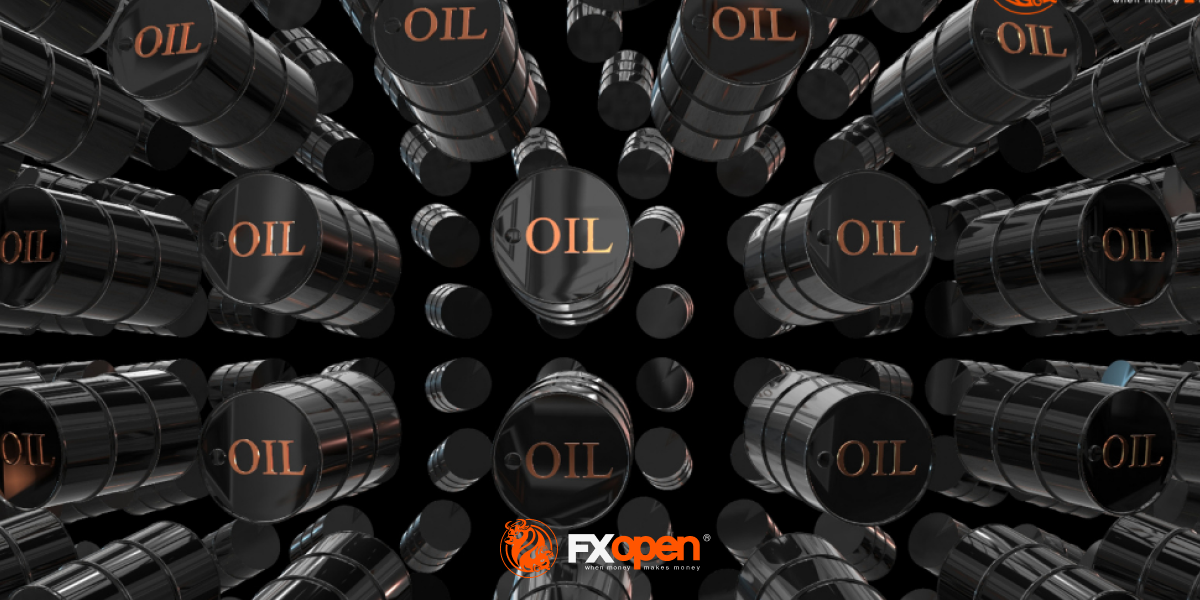FXOpen

Learning how to trade crude oil requires a nuanced understanding of its fundamental aspects, instruments, and trading strategies. This comprehensive article offers insights into the critical elements that affect crude oil prices, the range of instruments available for trading, and specific strategies traders use in this market.
The Basics of Crude Oil
Crude oil, often referred to as "black gold," is a fossil fuel derived from the remains of ancient organic matter. It serves as a crucial raw material for various industries, including transportation, chemicals, and manufacturing.
Two primary types of crude oil traded on global markets are West Texas Intermediate (WTI) and Brent Crude. WTI is primarily sourced from the United States and is known for its high quality and low sulphur content. On the other hand, Brent Crude originates mainly from the North Sea and serves as an international pricing benchmark.
The Organization of the Petroleum Exporting Countries (OPEC), which includes members like Saudi Arabia, Iran, and Venezuela, plays a pivotal role in determining global oil supply. By adjusting production levels, OPEC influences crude oil prices significantly. Additionally, other countries like Russia and the United States contribute to the world's oil supply, further affecting market dynamics.
What Time Does the Oil Market Open?
Like forex markets, crude oil trading hours are nearly 24/5. They’re typically highly liquid and offer traders multiple opportunities across a given day. For example, the New York Mercantile Exchange (NYMEX) opens for trading from Sunday evening to Friday afternoon, with a brief daily trading break.
Activity is most intense during the US session, which runs from 9:00 AM to 17:00 PM EST, and the European session, from 2:00 AM to 11:00 AM EST. These periods coincide with peak market activity and are generally the most volatile, with the overlap between the US and European sessions (between 9:00 AM and 11:00 AM EST) offering the greatest volatility and trading activity.
Factors Affecting Crude Oil Trading
In oil trading, economics is a fundamental aspect that traders need to grasp to make educated decisions. Several factors drive the price of crude oil, and here are some of the most significant:
- Supply and Demand: At its core, the price of crude oil is determined by how much of it is available (supply) versus how much is wanted (demand). An oversupply can depress prices, while high demand can cause prices to spike.
- Geopolitical Events: Conflicts, wars, and diplomatic tensions in oil-producing regions can disrupt supply chains, affecting prices. For instance, sanctions on Iran or instability in Venezuela can push prices higher.
- Currency Fluctuations: Oil prices are generally quoted in US dollars. A strong dollar can make oil more expensive for countries using other currencies, thereby affecting demand.
- Seasonal Changes: During winter, demand for heating oil can rise, pushing crude oil prices up. Conversely, a mild winter might result in lower demand and prices.
- Technological Advances: Innovations in extraction methods, such as fracking, can alter the supply landscape, making it easier to extract oil and thereby affecting prices.
- OPEC Decisions: As previously mentioned, OPEC has a significant influence on oil prices. Their production quotas can tighten or flood the market, causing price swings.
- Economic Indicators: Data like unemployment rates, manufacturing output, and interest rates can indicate the health of an economy, which in turn can affect oil consumption and prices.
- Environmental Policies: Increasing regulations and policies aimed at reducing carbon emissions and promoting renewable energy sources can impact the demand and supply of crude oil, thereby influencing prices.
- Natural Disasters: Events such as hurricanes, earthquakes, and other natural disasters can disrupt oil production and supply chains, leading to fluctuations in crude oil prices.
- Global Economic Growth: The overall growth of the global economy plays a critical role in crude oil demand. Economic booms often lead to higher energy consumption, driving up oil prices, while economic slowdowns can reduce demand and lower prices.
How Is Crude Oil Traded?
When learning how to trade oil, traders have a variety of instruments to choose from.
CFDs
Contracts for Difference (CFDs) are popular instruments when trading crude. CFDs are used by traders to speculate on price movements without owning the underlying asset. Essentially, a CFD is a contract between a trader and a broker to exchange the difference in price from the point the position is opened to when it is closed. One of the key benefits is the use of leverage, which means traders can control a larger position with a smaller initial investment, amplifying both potential returns and losses.
Margin requirements vary by broker but are typically lower for CFDs on oil compared to some other instruments. This makes it appealing for crude oil day trading strategies, where traders aim to capitalise on short-term price movements. However, managing risk effectively is crucial, as the leveraged nature of CFDs can result in significant losses if the market moves against you.
At FXOpen, we offer both CFDs on WTI Crude oil and Brent Crude. Head over there to explore a world of trading tools and other assets beyond crude oil.
Futures
Futures contracts are another well-established avenue for trading crude oil. Unlike CFDs, futures are standardised agreements to buy or sell a specific quantity of oil at a predetermined price at a set date in the future. They are traded on regulated exchanges, providing an added layer of transparency and security.
Spot Market
In spot trading, one buys or sells crude oil and takes immediate delivery and ownership. Unlike futures and CFDs, there's no leverage in spot trading, making it a less risky option. However, the absence of leverage requires a higher initial investment. While retail traders often avoid spot trading due to storage and transportation challenges, it's commonly used by entities directly involved in production or consumption. This method is more straightforward but demands the logistical capabilities that individual traders usually lack.
ETFs
Exchange-traded funds (ETFs) offer an alternative for those interested in the crude oil market without dealing with futures contracts or physical ownership. Crude oil ETFs typically track the price of oil or related indices by holding futures contracts or a blend of oil company stocks. This allows investors to indirectly gain exposure to oil price movements with less complexity.
Investing in a crude oil ETF can provide a degree of diversification, as these funds may also include assets like bonds or other commodities in their portfolio. However, it's essential to be aware of the management fees and potential tracking errors in the ETF's performance compared to the actual commodity.
Stocks
Another route to gain exposure to the crude oil market is by investing in the stocks of companies involved in the industry. This includes major producers, refineries, and even transportation companies. By owning shares in these businesses, investors are indirectly influenced by crude oil prices. To use an example, a rise in oil prices often boosts the profitability of oil-producing companies, potentially leading to stock price appreciation.
Unlike trading futures or CFDs, investing in stocks means actually owning a piece of the company, often with the added benefits of dividends. However, conducting thorough research is crucial, as these stocks can be affected by company-specific risks in addition to oil price movements.
Crude Oil Trading Strategies
Given the volatile nature of crude oil prices, traders employ specific strategies to capitalise on price fluctuations. Here are some strategies that may be useful for crude oil trading:
Trend Following with Moving Averages
The trend is your friend, especially in commodities like crude oil. This is a well-known technique but it may be very useful for commodity trading. One effective way to follow the trend is by using moving averages, such as the 50-day (blue) and 200-day (orange). When the 50-day crosses above the 200-day, it's generally a bullish signal, and vice versa for a bearish trend. However, as with all technical analysis tools, moving averages can sometimes trigger false signals.
Range Trading
Due to supply-demand dynamics and geopolitical factors, crude oil prices often fluctuate within a specific range. Identifying these ranges can be useful for short-term trading. Traders buy at the lower end of the range and sell at the higher end, applying technical indicators like RSI or Stochastic Oscillator for entry and exit signals.
News-Based Trading
In crude oil markets, news about OPEC decisions, US oil inventory data, geopolitical tensions, and technological advancements can dramatically impact prices. Traders keeping an eye on oil news can take advantage of sudden announcements or an economic release likely to push prices in a particular direction. Given the high leverage commonly available in CFD trading, this strategy can be effective but also comes with significant risk.
Trade Crude Oil at FXOpen
Trade WTI and Brent Crude oil CFDs at FXOpen to take advantage of our competitive spreads, high liquidity, and lightning-fast execution speeds.
We offer four different trading platforms, MetaTrader 4, MetaTrader 5, TickTrader, and TradingView, each with desktop, web-based and mobile versions for access anytime and anywhere. Take advantage of advanced technical analysis tools, including many trading tools and expert advisors for automated trading.
Traders can rest easy knowing that FXOpen is also regulated by the FCA in the UK, CySEC in Cyprus, and is licensed to provide financial services in Australia: AFSL 412871 – ABN 61 143 678 719. Start trading oil and gas commodity CFDs with confidence at FXOpen and explore a world of trading opportunities across more than 600 markets.
To access crude oil markets with competitive spreads and rapid execution speeds, consider opening an FXOpen account today and step confidently into the world of crude oil trading.
The Bottom Line
In crude oil trading, having the right strategies and tools is essential. By understanding the fundamentals, market dynamics, and utilising specific trading techniques, you are now equipped with the knowledge you need to get started!
FAQ
How to Trade Brent Crude Oil?
To trade Brent Crude oil, you can use various instruments such as futures contracts, CFDs, ETFs, or stocks of oil companies. Most retail traders use CFDs, which provide a way to speculate on price movements without owning the asset. CFDs also allow for leverage, which can amplify both potential gains and losses.
What Is the Brent Oil Trading Strategy?
A common Brent oil trading strategy involves trend following using moving averages. For instance, traders use the 50-day and 200-day moving averages to identify bullish or bearish trends. Range trading and news-based trading are also popular strategies.
What Hours Does Crude Oil Trade?
Crude oil trades nearly 24/5. The New York Mercantile Exchange (NYMEX) operates from Sunday evening to Friday afternoon with a daily break. The most active trading occurs during the US session (9:00 AM to 2:30 PM EST) and the European session (6:00 AM to 11:00 AM EST).
What Is the Best Time to Trade Brent Crude Oil?
According to theory, the best time to trade Brent Crude oil is during the overlap of the US and European sessions, from 9:00 AM to 11:00 AM EST, when market liquidity and volatility are highest. However, you should consider fundamental factors as they can lead to unexpected price movements.
This article represents the opinion of the Companies operating under the FXOpen brand only. It is not to be construed as an offer, solicitation, or recommendation with respect to products and services provided by the Companies operating under the FXOpen brand, nor is it to be considered financial advice.
Stay ahead of the market!
Subscribe now to our mailing list and receive the latest market news and insights delivered directly to your inbox.








